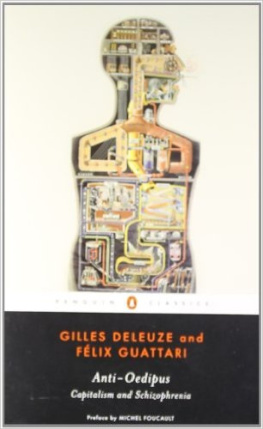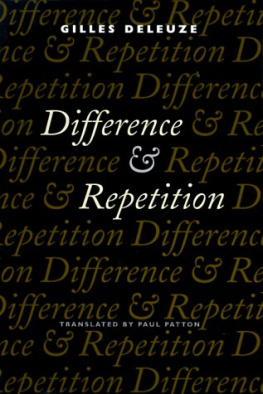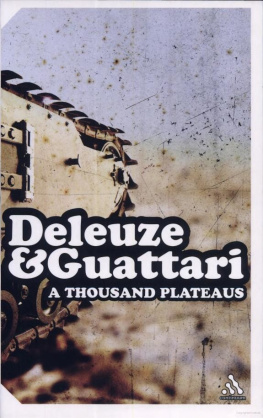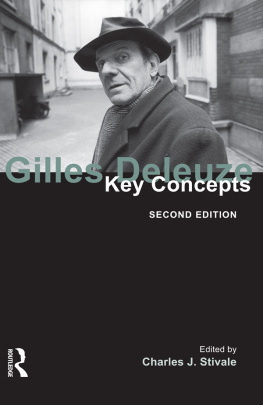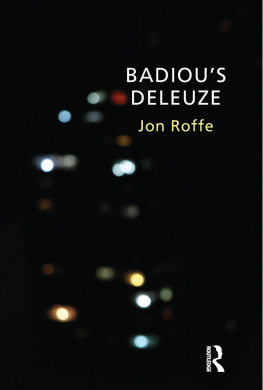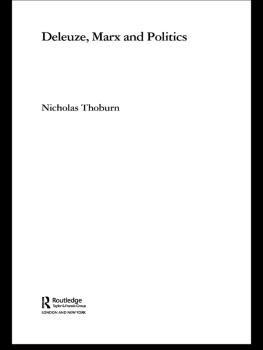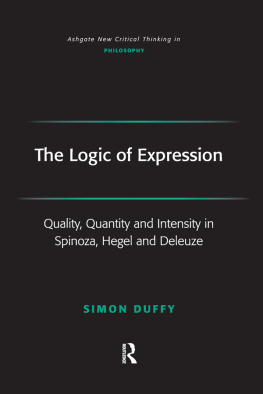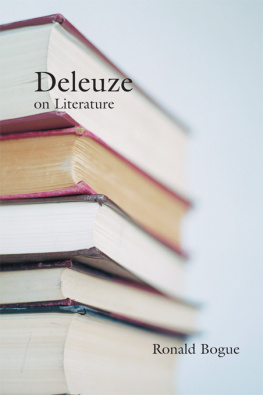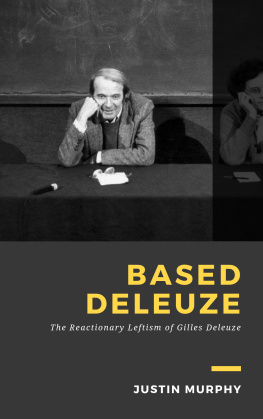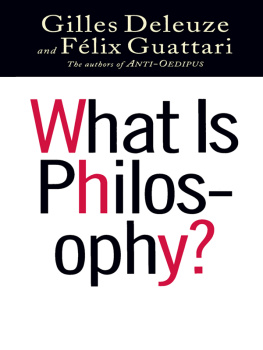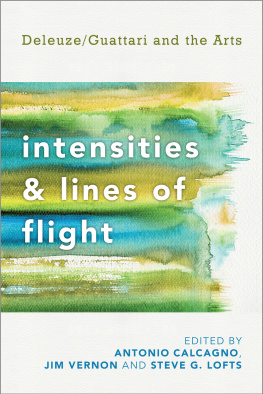Gilles Deleuze - Cinema I: The Movement-Image
Here you can read online Gilles Deleuze - Cinema I: The Movement-Image full text of the book (entire story) in english for free. Download pdf and epub, get meaning, cover and reviews about this ebook. year: 1986, publisher: University of Minnesota Press, genre: Religion. Description of the work, (preface) as well as reviews are available. Best literature library LitArk.com created for fans of good reading and offers a wide selection of genres:
Romance novel
Science fiction
Adventure
Detective
Science
History
Home and family
Prose
Art
Politics
Computer
Non-fiction
Religion
Business
Children
Humor
Choose a favorite category and find really read worthwhile books. Enjoy immersion in the world of imagination, feel the emotions of the characters or learn something new for yourself, make an fascinating discovery.

- Book:Cinema I: The Movement-Image
- Author:
- Publisher:University of Minnesota Press
- Genre:
- Year:1986
- Rating:5 / 5
- Favourites:Add to favourites
- Your mark:
- 100
- 1
- 2
- 3
- 4
- 5
Cinema I: The Movement-Image: summary, description and annotation
We offer to read an annotation, description, summary or preface (depends on what the author of the book "Cinema I: The Movement-Image" wrote himself). If you haven't found the necessary information about the book — write in the comments, we will try to find it.
Cinema I: The Movement-Image — read online for free the complete book (whole text) full work
Below is the text of the book, divided by pages. System saving the place of the last page read, allows you to conveniently read the book "Cinema I: The Movement-Image" online for free, without having to search again every time where you left off. Put a bookmark, and you can go to the page where you finished reading at any time.
Font size:
Interval:
Bookmark:

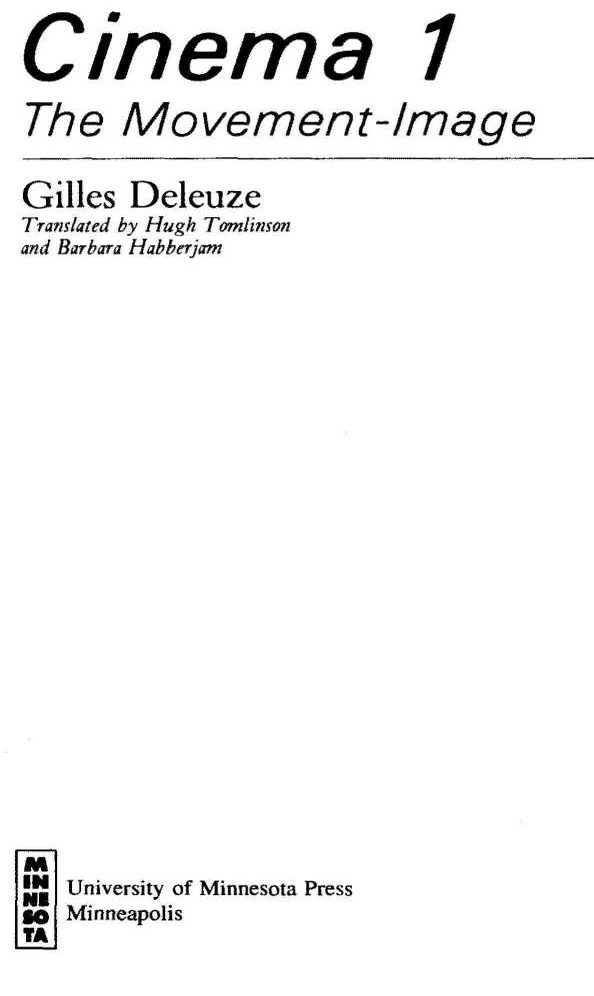
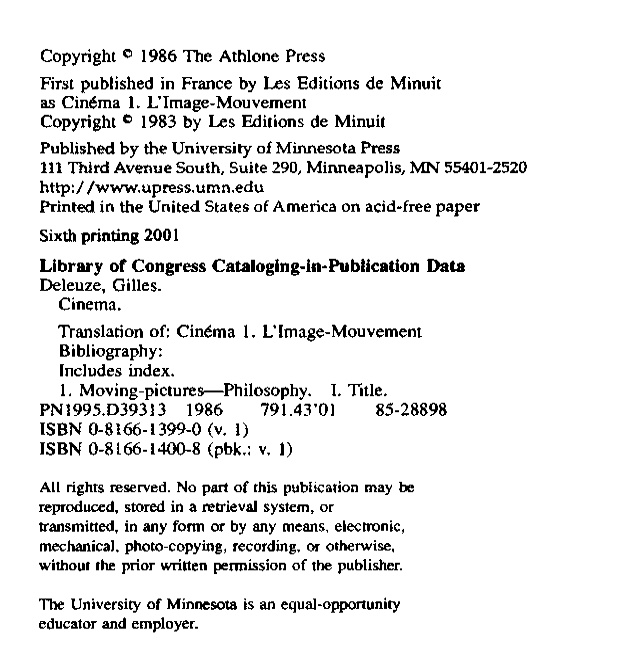
Preface to the English Edition
T his book does not set out to produce a history of the cinema but to isolate certain cinematographic concepts. These concepts are not technical (such as the various kinds of shot or the different camera movements) or critical (for example the great genres, the Western, the detective film, the historical film, etc.). Neither are they linguistic, in the sense in which it has been said that the cinema was the universal language, or in the sense in which it has been said that the cinema is a language. The cinema seems to us to be a composition of images and of signs, that is, a pre-verbal intelligible content ( pure semiotics ) , whilst semiology of a linguistic inspiration abolishes the image and tends to dispense with the sign. What we call cinematographic concepts are therefore the types of images and the signs which correspond to each type. The image of the cinema being, therefore, automatic and presented primarily as movement-image, we have considered under what conditions it is specifically defined into different types. These types are, principally, the perception-image, the affection-image and the acton-image. Their distribution certainly does determine a representation of time, but it must be noted that time remains the object of an indirect representation in so far as it depends on montage and derives from movement-images.
It is possible that, since the war, a direct time-image has been formed and imposed on the cinema. We do not wish to say that there will no longer be any movement, but that just as happened a very long time ago in philosophy a reversal has happened in the movement-time relationship; it is no longer time which is related to movement, it is the anomalies of movement which are dependent on time. Instead of an indirect representation of time which derives from movement, it is the direct time-image which derives from movement, it is the direct time-image which commands the false movement . Why did the war make possible this reversal, this emergence of a cinema of time, with Welles, with neo-realism, with the new wave...? Here again, it will be necessary to discover which types of images correspond to the new time-image and which signs combine with these types. Everything perhaps suddenly appears in a shattering of the sensory-motor schema: this schema, which had linked perceptions, affections and actions, does not enter a profound crisis without the general regime of the image being changed. In any case, the cinema has undergone a much more important change here than the one which happened with the talkie.
It is not a matter of saying that the modern cinema of the timeimage is more valuable than the classical cinema of the movementimage. We are talking only of masterpieces to which no hierarchy of value applies. The cinema is always as perfect as it can be, taking into account the images and signs which it invents and which it has at its disposal at a given moment. This is why this study must interweave concrete analyses of images and signs with the monographs of the great directors who have created or renewed them.
The first volume deals with the movement-image. The second will deal with the time image. If, at the end of this first volume, we try to understand the full importance of Hitchcock one of the greatest English film-makers - it is because we think he invented an extraordinary type of image: the image of mental relations. Relations, as external to their terms, have always been the subject of English philosophical thought. When a relation terminates or changes, what happens to its terms? Thus Hitchcock asks in Mr and Mrs Smith, a minor comedy, what happens to a man and a woman who suddenly learn that, as their marriage is not legal, they have never been married? Hitchcock produces a cinema of relation, just as English philosophy produced a philosophy of relation. In this sense he is, perhaps, at the juncture of the two cinemas, the classical that he perfects and the modern that he prepares. In all these respects, it is not sufficient to compare the great directors of the cinema with painters, architects or even musicians. They must also be compared with thinkers. The question of a crisis of the cinema is often raised under the pressure of television, then of the electronic image. But the creative capacities of both are inseparable from what the great directors of the cinema contribute to them. Rather like Varese in music, they lay claim to the new materials and means that the future makes possible.
Gilles Deleuze
Translators Introduction
T his is Gilles Deleuzes first book on film, published in France in October 1983. It is an illustration and exemplification of Deleuzes radical view of philosophy developed in a series of major works, from Difference et Repetition to Mille Plateaux.
Thus, in one sense, it is a work of philosophy. Philosophy in the traditional sense of the word, the creation of concepts. Beginning from an analysis of Bergson, the book puts forward a view of the image which is radically different from that which dominated classical philosophy. This account is combined with an interpretation of the classification of types of signs advanced by Peirce to provides powerful typology with which to approach images of all types.
On the other hand, this is plainly a book about the cinema. Not only does it discuss a large number of images from particular films, but it also advances a series of general views about the types to which particular films belong. This may lead the reader to classify it as a work of film theory in the traditional sense. This would be a mistake.
For Deleuze, philosophy cannot be a reflection on something else It is, as we have said, a creation of concepts. But concepts, for Deleuze, are thought of in a new way. They are no longer concepts of, understood by reference to their external object. They are exactly like sounds, colours or images, they are intensities which either suit you or dont, which work or dont. Concepts are the images of thought.
The function and purpose of philosophy itself changes. Philosophy is not in a state of external reflection on other domains, but in a state of active and internal alliance with them, and it is neither more abstract nor more difficult. Therefore, it is not a question of reflecting on the cinema, it is normal that philosophy produces concepts which are in resonance with the pictorial images of today or with cinemamatographic images . Thus Deleuze is engaged in the work of concept creation alongside the cinema. New concepts are invented, on the basis of some well-known philosophical themes, and then put to work in the cinema.
This Deleuzian approach will seem strange to those schooled in more traditional philosophical themes. It will perhaps seem less strange to those who work in the cinema and are constantly involved in processes of creation of their own. One startling by-product of Deleuzes way of working is that the usual boundaries between disciplines lose their relevance and sense as new assemblages are created. Who would have thought that the historical films of Cecil B. de Mille could be brought into productive relationship with Nietzsches essay on nineteenth-century German historiography? Finally, these conjunctions between particular themes illustrate a broader conjunction between philosophy and the cinema, one which makes a work of this type particularly productive. For what is interesting in philosophy is that it proposes a cutting [ decoupage ] of things, a new cutting: it groups under a single concept things that one would have thought were different, and it separates from it others which one would have thought very close. Now, the cinema by itself is also a cutting of visual and sound images. There are modes of cutting which can converge.
Font size:
Interval:
Bookmark:
Similar books «Cinema I: The Movement-Image»
Look at similar books to Cinema I: The Movement-Image. We have selected literature similar in name and meaning in the hope of providing readers with more options to find new, interesting, not yet read works.
Discussion, reviews of the book Cinema I: The Movement-Image and just readers' own opinions. Leave your comments, write what you think about the work, its meaning or the main characters. Specify what exactly you liked and what you didn't like, and why you think so.

